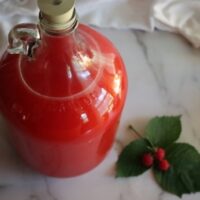Raspberry Wine
3 3/4 quarts water, filtered and unclorinated2 1/2 lbs sugar (or 2 3/4 lbs mild honey for mead)3 to 4 lbs raspberries, fresh or frozen1/2 tsp. acid blend1/8 tsp. tannin powder1 tsp yeast nutrient1/2 tsp. pectic enzyme1 packet Montrachet Wine Yeast or Champagne Yeast
Instructions
- Pick over the raspberries, removing any moldy fruit, stems, and leaf material. Wash the fruit and place them mesh brewing bag or tie them into a bit of cheesecloth to keep them contained.
- Place the bag of raspberries into a plastic fermenter (minimum 2 gallons).
- Bring the water and sugar to a hard boil on the stove, stirring to dissolve the sugar. Pour the boiling water over the fruit. The hot water will help set the color of the fruit, ensuring a bright red finished wine.
- Add the acid blend, tannin, and yeast nutrients. Stir to dissolve and incorporate. Don't add the yeast at this point! The boiling water is good for extracting color and dissolving everything, but it'll kill the yeast.
- Allow the mixture to cool completely until it's at room temperature. Once cool, add the pectic enzyme and yeast packet.
- Cover the bucket with a towel and allow the mixture to ferment in the bucket for 7 to 10 days. This is known as primary fermentation, and you don't need a water lock at this point.
- After 7-10 days, the fermentation should be less vigorous. and it's time to move the mixture into a fermenter with a water lock. Remove the raspberry bag and use a siphon to transfer the wine to a narrow neck 1-gallon glass carboy (demijohns). Add water to fill if necessary.
- Cap with a water lock and allow the mixture to ferment in secondary for 4 to 6 months. During the secondary, be sure to rack the wine off its sediment at least once, after a month or two in secondary. To rack, just use a siphon to transfer the wine to another carboy, topping off with water or dry neutral white wine if necessary to fill. Be sure to re-seal the water lock.
- After 4-6 months, it's time to bottle the wine. If it's too dry for your tastes, add another 1/4 pound of sugar and rack it into a clean fermenter for another month before bottling. (If it's still too dry for your tastes, repeat the process again, adding another 1/4 lb and re-racking into a clean container.)
- Bottle the wine in wine bottles with corks, or in a pinch, you can use flip-top Grolsch bottles for short-term storage. If you plan on aging the wine for much more than 6 months, I'd recommend corked bottles. Either way, allow the wine to bottle condition for at least 1-2 months before drinking, preferably longer.
